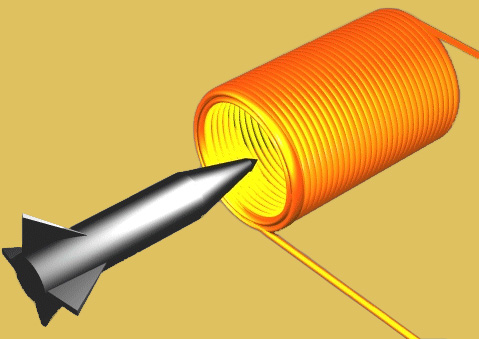
Practical Coilgun Design
Magnetic Materials
- Magnetic Materials
- Solenoid Physics
- Magnetic Field
- Force From Magnetism
- Saturation
- Saliency Ratio
- Salient Pole Motors
- Electromagnetic Guns
- Widescreen LCD
- IEEE Articles
- Bibliography
Force - Where Does It Come From?
Okay, so you have some iron in a magnetic field. So what? Where does the force come from? When you hold two magnets and bring them together, you can feel the force but not see it. So it seems mysterious, but it must have something in common the more familiar forces, right?
This page briefly summarizes the physics of forces, along with some math that I can't explain. For a serious understanding you'll need to pursue a college physics course or textbook.
Force Is the Gradient of Potential Energy
Force is the gradient of potential energy. ![]()
This is true for anything: gravity, electric fields, mechanical force, springs and rubber bands, air pressure, magnetism. Anything you can think of!
The gradient operator ![]() tells
how a function varies in different directions. It is a vector given by these two rules:
tells
how a function varies in different directions. It is a vector given by these two rules:
- It points in the direction in which f(x, y, z) increases most rapidly;
- Its magnitude is the rate of change of f(x, y, z) with respect to distance in that direction.
In short, the gradient tells you how to calculate directional derivatives.
If a system has a potential energy field, then it invariably generates forces. "Potential energy" is defined by the stored energy as a result of an object's position.
Force In a Magnetic Field
The potential energy in a magnetic field is ![]()
where ![]() is magnetic
induction vector,
is magnetic
induction vector,
and ![]() is dot product,
is dot product,
and![]() is magnetic moment
vector.
is magnetic moment
vector.
Recall that , i.e. magnetic induction vector B is equal to permeability µ multiplied by magnetic field vector H.
Therefore the energy density in a magnetic field is ![]()
Note that force units depend on your choice of systems:
| MKS: | |
| CGS: |
Although the equations look similar, these are fundamentally different units. They are not basically comparable since they have different dimensions.
| < Previous | Page 4 of 11 | Next > |
©1998-2025 Barry Hansen